Chiang Mai, Chiang Rai, The Golden Triangle Travel (Part II)
[continued from “Chiang Mai, Chiang Rai, The Golden Triangle Travel (Part I)”]
Chiang Mai Travel
Day 3 : Thursday 6 July 2006 Maesa Elephant Camp
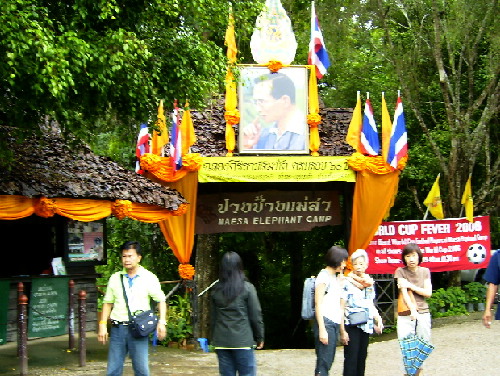
Maesa Elephant Camp Entrance
The tropical monsoon forests in north Thailand produce durable hardwoods. The best wood is teak as it has great durability, strength and immunity to shrinkage, fungus and insect attack. It is usually used for making furniture and building houses, ships and bridges.
Elephants are the Thais’ cultural icon. To the Thais, elephants are a symbol of fortune. According to their beliefs, one will get good luck if one passes under an elephant.
As elephants are large and strong many of them were used in the tropical monsoon forests to haul logs from the forests to the collecting points. Nowadays, as there are less forests to be logged some are used in the
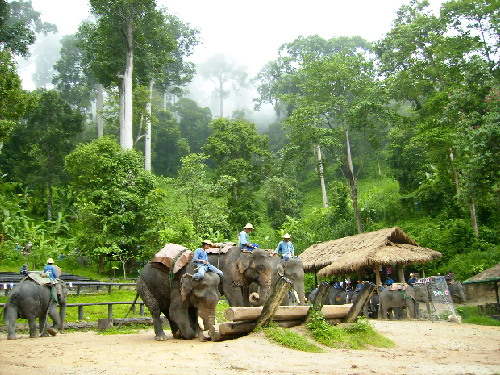
Maesa Elephant Camp in the lush green tropical monsoon forest
Thailand tourist industry. They are used to carry tourists for joyrides and show them their skills in logging, painting, dancing, etc Their amusing and amazing tricks are often greeted with rapturous applause from the spectators.
Maesa Elephant Camp To watch an elephant show, we went to Maesa Elephant Camp near Chiang Mai. On entering the camp, we saw several elephants bathing in a river. After bathing, they walked to an open space nearby where they would perform a show.
As we walked to the show ground, I saw a large board with a list of 77 elephants’ names and their ages ranging from 2 to 48 years old. Then we walked to a small stall and saw lots of drawings by elephants for sale. Each drawing had a photo of a
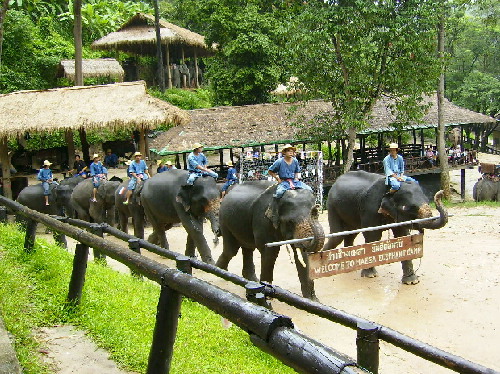
Elephants welcoming the spectators
proud artist and cost a few thousand Thai baht! Entering the elephant show ground, we saw lots of people who had already taken their seats.
An Amazing Elephant Show Soon the show started with two elephants walking majestically and carrying a big signboard round the place. The signboard said “WELCOME TO MAESA ELEPHANT CAMP”. It was followed by a few elephants.
After the welcoming ceremony, the elephant show began. The animals performed some interesting and entertaining acts like blowing harmonicas and dancing at
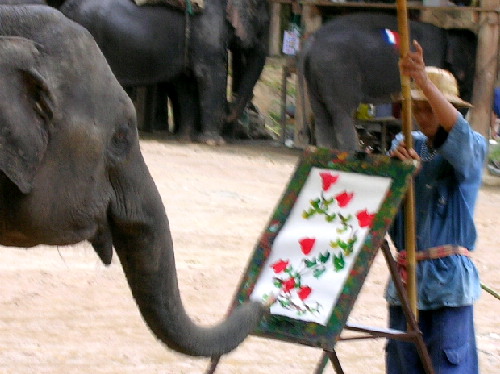
A Talented Artist
the same time, kicking a large football into a goal-mouth, painting, showing off massaging skills, playing a pick-up-stick game and logging. The show ended with the same elephants carrying another signboard which said “THANK YOU. HAVE A NICE DAY”.
The Amazing Elephant Artists There were two performances that amazed the spectators and me too, namely the painting session and the football penalty shoot-out. It was fascinating to watch six elephants using water-colours to paint trees, flowers and their own species in the centre of the ground. With the paint brushes in their trunks, they slowly painted on white papers on the easels. They painted like a professional without any help except dipping their brushes in
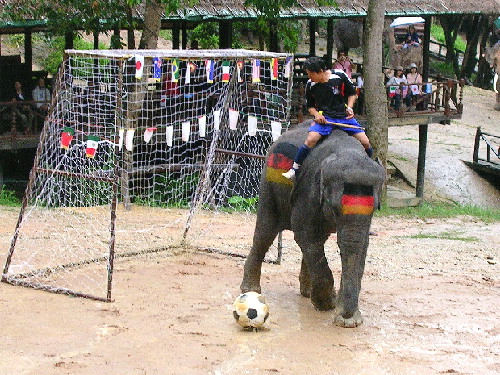
A “German’ Goalkeeper
water-colours by their masters. As soon as the elephants finished their painting, we were surprised to see a middle-aged European lady in the audience jumped up, pointed at a drawing with red flowers and shouted repeatedly, “I want to buy that painting.”
Penalty Shoot-Out by Elephants The penalty shoot-out by two elephants was an entertaining one. One of them had a France flag painted on its body while the other a Germany flag. After a few shoot-outs, guess which elephant won the penalty shoot-out? It was the one with the Germany flag as the score was 1 – 0. We cheered and clapped loudly as the elephant that won kept on swinging its trunk in jubilation. But, the coming World Cup Final on 9 July
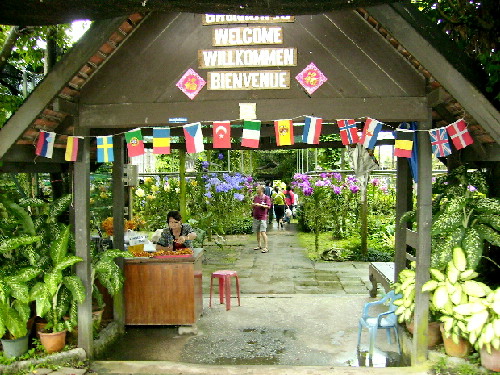
Mae Ram Orchid Farm Entrance
2006 was between Italy and France. ( Italy won the World Cup 2006 on penalty shoot-out : 4 – 2)
The elephant show is worth seeing. I think the elephant-masters should get the credit for the fantastic show.
After the elephant show we went to an orchid farm known as Mae Ram Orchid.
Mae Ram Orchid Farm Mae Ram Orchid Farm is located along Mae Rim – Samoeng route. It has a large collection of different types of orchids of different colours, shapes and sizes.
Orchids are flowering plants belonging to over 800 families (genera) which
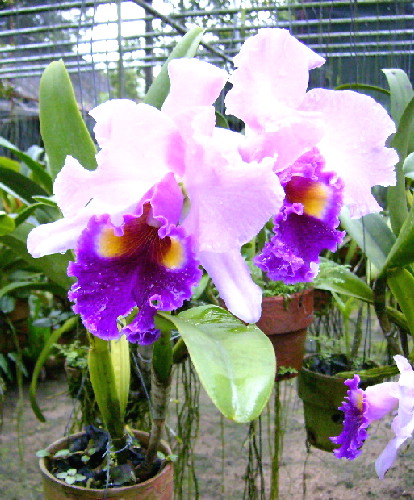
White and purple orchid flowers
have over 25,000 species. Their flowers of different colours are beautiful to look at.
At the orchid farm, we saw quite a number of them blooming with colourful flowers. They were so beautiful that we wasted no time snapping photographs of them. Unfortunately, we cannot remember their long names.
Having seen all the stunning orchid plants, we went to the back of the farm to see butterflies. Unfortunately, we saw workers pulling down the butterfly enclosures. We guessed they were going to build new ones for the butterflies.
We left the orchid farm for an exciting and thrilling snake show at Mae Sa Snake Farm which is nearby.
Mae Sa Snake Farm Mae Sa Snake Farm is located along Maerim-Samerng Road. It is the largest snake farm in 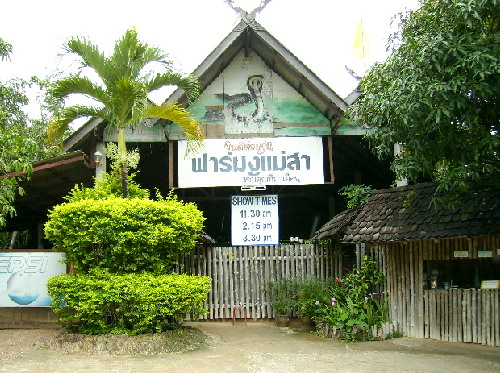 northern Thailand. Many kinds of poisonous and non-poisonous snakes are found here. To attract tourists, it offers three snake shows a day.
northern Thailand. Many kinds of poisonous and non-poisonous snakes are found here. To attract tourists, it offers three snake shows a day.
When we entered the farm, we were in a place where a snake show had just started. We sat on long wooden blanks with other tourists and watched the show. It was performed by two young, energetic and brave men in a ring.
In the show a performer showed us the way he milked the snake’s venom. After that
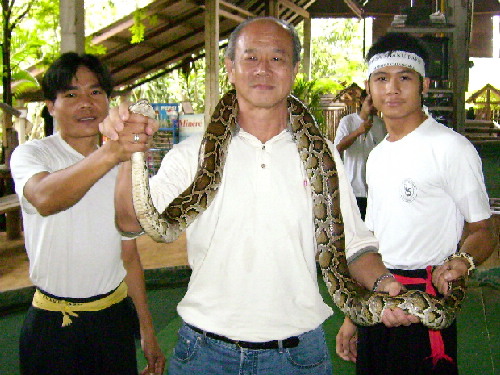
Writer holding a large python
the two fearless men performed dangerous tricks with other poisonous snakes that kept us on edge most of the time.
A Large Python In the middle of the show, the two men encouraged us to enter the ring and hold a large python. At first I did not think of getting near one as I was always wary of it. But when I saw two young boys entering the ring and holding the snake bravely, my fear for snakes suddenly disappeared. Without hesitation, I entered the ring and asked the two men to allow me to hold it. While holding the head of the snake in my right hand and its tail in my left, I posed fearlessly with the tame snake. That was my first unforgettable experience of holding and touching a cold-blooded creature.
“A Jumping Poisonous Snake” Dring the last trick of the show, the performers told us that there was a jumping
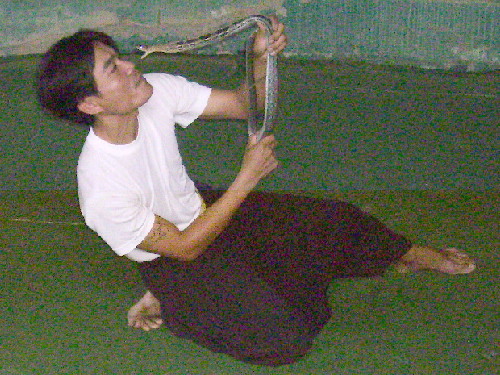
A snake-performer dicing with death
poisonous snake in a box. Opening the box, they used sticks to poke at the snake inside. Suddenly, one of them using his stick flung the snake out of the box and it landed on one of the spectators, a young girl. She jmped up and screamed. All of us were shocked and wondered whether she was bitten by the snake. One of the performers rushed to the victim, picked up the snake from the ground and showed us a long piece of rope instead. When we knew it was a trick, we burst into laughter. The performer apologized to the “victim” profusely. We sympathized with the “victim” as that was a traumatic experience for her.
Snakes in Enclosures After the snake show, we walked to the back of the
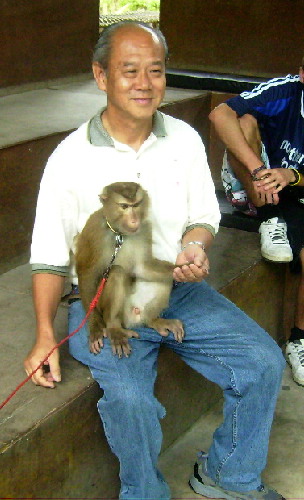
Writer befriending a monkey at the Monkey Centre
farm and saw a variety of snakes in their enclosures. Unfortunately, we could not see them clearly as the holes of the net round each enclosure were small. But we saw some snakes resting in the trees. Then we left and went to the Monkey Centre to watch a monkey performance.
The Monkey Centre The monkey show at the Monkey Centre was our last animal show. It is located near the Mae Sa Snake Farm along the Maerim-Samerng Road.
Monkey Tricks The show was an enjoyable one as those amazing monkeys could do a variety of tricks including plucking coconuts, shooting a basketball, cycling a small tricycle, selling medicine to spectators, looking for a spectator’s watch in a pool of water, pushing a cart of coconuts and picking the correct number which a spectator had asked for.
A Number Game Among all the monkey tricks, there was one that puzzled the

“Is this the number you want?” the monkey seemed to ask showing the little board with number “4” written on it.
spectators and me. In that trick, a monkey master put eight small wooden square boards each with a number on the floor. The numbers were from 1 to 8. He then asked a spectator to turn over all the boards so that the numbers could not be seen and mix them up. After that he asked another spectator for a number he wanted the monkey to pick. When the master told the monkey to pick number “4” which the spectator had asked for, it walked to the row of the overturned boards, thought for awhile, picked up one of them and showed it to the spectators. Unbelievably, it had taken the correct one. We were all amazed.
To convince us that the monkey was smart, the master asked another spectator for a different number which was “7”. After the boards were reshuffled (without the numbers being seen) by another spectator, the master told the monkey to
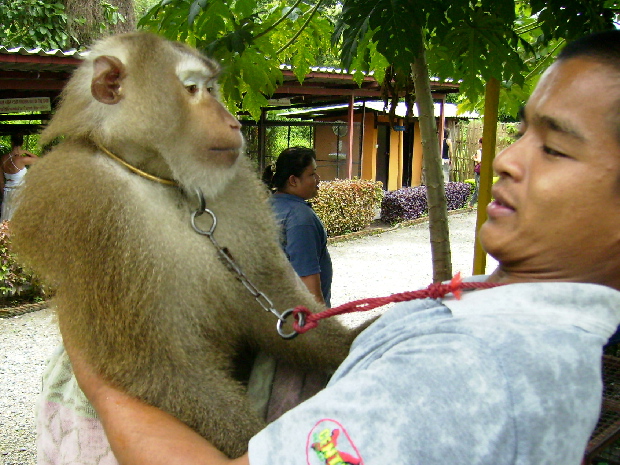
A good bond between a human being and an animal
pick the board with number “7”. Amazingly, the monkey got the right one again. We were all quite impressed and wondered how it did it again.
After the fantastic monkey show, we left for the largest temple in Chiang Mai, Wat Phratat Doi Suthep. It is on top of a high hill known as Doi Suthep overlooking Chiang Mai.
Wat Phratat Doi Suthep Chiang Mai has over 300 temples. They add to its rich cultural heritage. They play an important role in the Thais’ ritual and social life. Many old ones have been restored to their former glories and are now a tourist attraction.
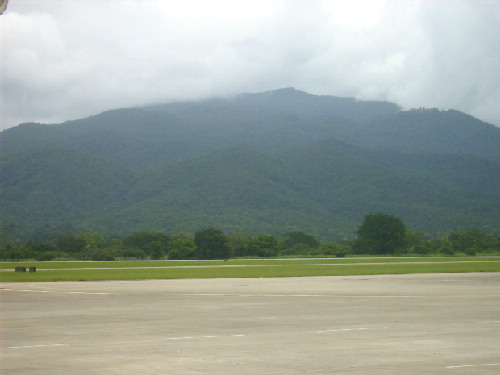
Wat Phratat Doi Suthep is on top of Doi Suthep Mountain
Among all the temples in Chiang Mai, Wat Phratat Doi Suthep is the most famous. It is located on top of a lush green rainforest-covered mountain called Doi Suthep which is about 1066 metres above sea-level.
Kru Ba Sivichai(1878-1938) At the foot of the mountain, there is a monument in memory of a famous Lanna monk, Kru Ba Sivichai, who had supervised the construction of a road up to the top of the mountain in 1935 and the renovation of over 100 local temples.
Future Tourist Development Projects The Thai government has several tourist development projects for the Doi Sutthep area such as a night
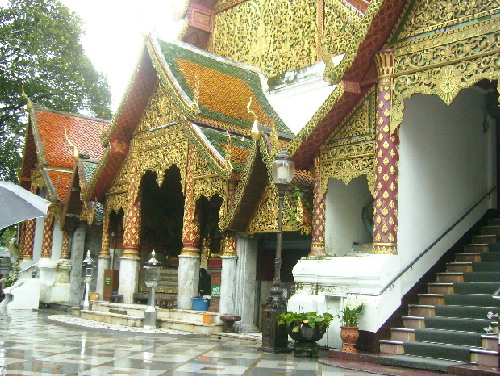
Wat Phratat Doi Suthep
safari park, elephant park, world garden, theme or amusement park and mass transit monorail system. Some of the local people are not happy with the projects as they fear the charm, beauty, tranquility and sacred atmosphere of the place will be gone.
Wat Phratat Doi Suthep It was raining heavily when we reached the foot of the mountain. To go up the mountain to Wat Phratat Doi Suthep, our coach-driver had to drive up a steep, winding and wet road, negotiate sharp bends cautiously and hope there was no landslide on the way.
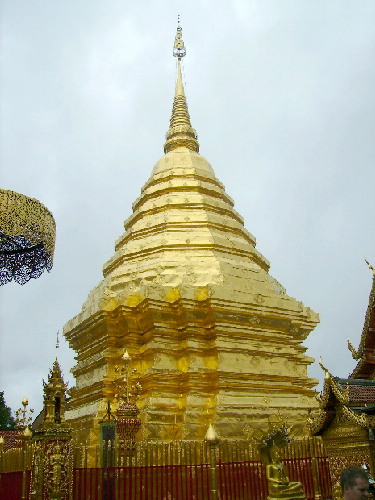
Golden Stupa of Wat Phratat Doi Suthep
When we arrived at the bottom of the temple, it was already shrouded in thick mist. There are two ways of getting to the temple: either one climbs the 306 steps or takes an inclined lift to the temple. A friend of mine and I decided to take the inclined lift to the temple as it was still raining. The rest of them preferred to shop for clothes and souvenirs at the car-park at the bottom of the temple.
Buddha’s Relics On reaching the top, we were charmed by the beauty of Wat Phratat Doi Suthep or Doi Suthep Temple. It has two large golden statues of Buddha in their beautifully and intricately designed buildings, a large golden pagoda-like structure or stupa which enshrines the Buddha’s relics, a large parasol at each corner of the stupa, a chanting house with two legendary crocodiles in front and a white statue of an elephant. The latter is standing in front of the grand temple in memory of the elephant which brought the Buddha’s relics to the top of the mountain during the reign of King Kuena (1355 -1385). Besides, colourful murals
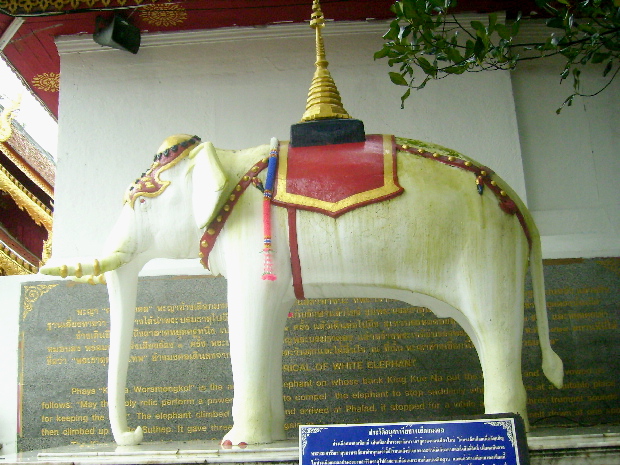
A monument at Wat Phratat Doi Suthep to the elephant that brought the Buddha’s relics to the temple
depicting Lord Buddha’s life, several small Buddha statues and two rows of bronze bells can be seen at the temple. We were surprised to see an old tall Jack- fruit tree with lots of fruits on the left of the temple. That is the oldest Jack-fruit tree I have ever seen.
A View-Point At the back of the temple, there is a view-point where we saw a breathtaking, panoramic view of the Chiang Mai city and its airport. We were lucky to see an aeroplane leaving the airport and climbing steeply to the sky with its engines roaring loudly and later another plane coming down slowly and landing at the airport. Occasionally, the view was blocked by thick passing clouds.
After spending some time at the sacred temple, we decided to walk down the 306 steps to the bottom of the temple. These steps are lined with two long,
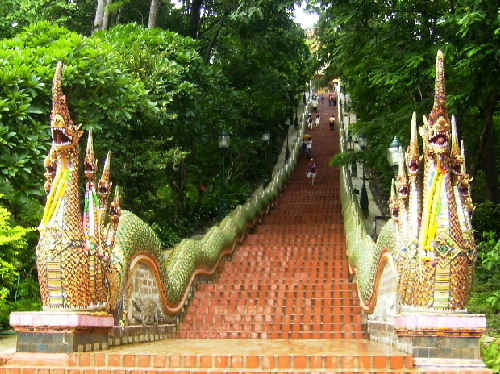
Naga Stairway of 306 steps to Wat Phratat Doi Suthep
colourful and scaly Siamese legendary dragons. Each of them has seven fierce-looking heads. The flight of 306 steps is known as Naga Stairway.
Soon we left Doi Suthep and went to Chiang Mai City to visit a museum known as Chiang Mai City Arts & Cultural Centre.
Chiang Mai City Arts & Cultural Centre This centre is actually the city’s museum which showcases Chiang Mai’s history, economies, customs, traditions, arts and cultures. It is along Prapokklao Road.
Statues of Great Thai Kings The museum is a historic building which was built in a royal architectural style in 1924. It was used for many purposes
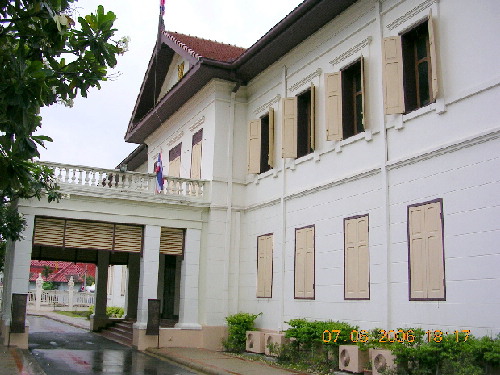
Chiang Mai City Arts and Cultural Centre (Museum)
before the museum took it over in 1997. Standing in front of the museum are three bronze statues of great Thai kings, namely King Mengrai in the middle, King Khum Maung on his right and King Ram Kam on his left. These statues are made in memory of them.
Exhibits in Museum In this museum one learns the development of the northern Thailand region and Chiang Mai city from pre-historical times to the present. To make the tourists understand these better, the museum has models, slides, pictures with explanations, audio and video presentations and graphic displays.
The exhibitions on the ground floor of the building are as follows:
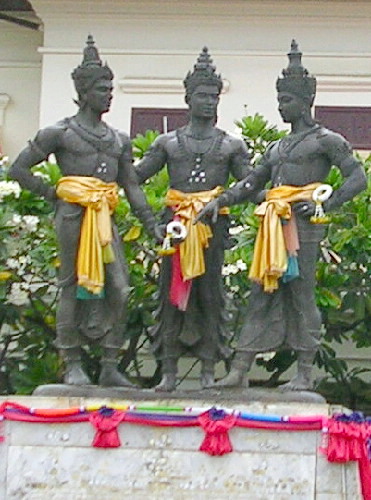
Monument to the Three Great Thai Kings
1 Chiang Mai Today
2 The Prehistory of Chiang Mai
3 The Civilization of the Kok and Ping River Valleys
4 Establishment of the City
5 Environment and Culture
6 The Past 100 Years of the City
7 Good Aspects of the City
Exhibitions on the 1st. Floor :
1 History of the Historical Building
2 The Rulers of Chiang Mai
3 Life on the Ping Riverbank
4 People of the Old City
5 Buddhism in Chiang Mai
6 The Office of the Former Governor
7 The Agricultural Society
8 The Mountain People
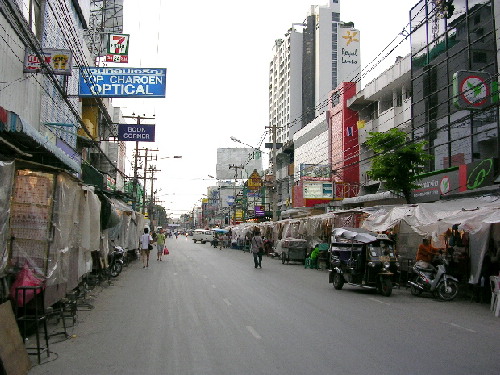
Chan Klan Road Night Bazaar, Chiang Mai
This museum is worth visiting if one wants to learn about Chiang Mai’s past and present.
Having visited the museum, we went to the Night Bazaar for dinner.
Chiang Mai Night Bazaar Located along the entire Chan Klan Road, the Night Bazaar is a shopping paradise for tourists in the evening. Shops along this road sell all kinds of locally and foreign made goods. In the evening, over a hundred street-vendors push their mobile stalls fully loaded with goods like clothing, DVDs, souvenirs, perfumes, accessories, handicrafts and many more to the roadsides.
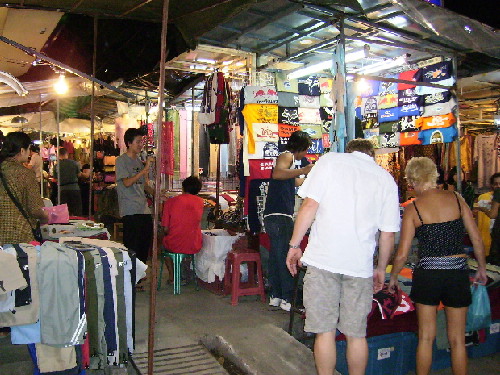
Roadside stalls along Chan Klan Road are opened in the evening
When night falls, this area will be crowded with shoppers and have an ambience of a carnival.
Pavilion Night Bazaar and Chiang Mai Night Bazaar Two large buildings known as Pavilion Night Bazaar and Chiang Mai Night Bazaar are located along Chan Klan Road. They house many stalls which sell all kinds of tourists’ goods such as silk, antiques, clothing, handicrafts, perfumes, watches, CDs, DVDs, shoes, painted umbrellas and many more. At such a place, one is expected to bargain with the vendors until one thinks that the prices are
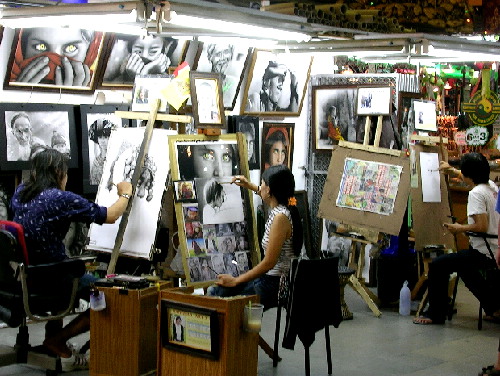
Artists at Chiang Mai Night Bazaar
reasonable.
Chiang Mai Artists At the Chiang Mai Night Bazaar, many artists can be seen busy drawing pictures in black and white or colours from the photos given by their customers. Besides, there are photo studios where one can take a photo in a traditional costume. With a little computer touch-up by the photo studios, customers will look several years younger in their photos.
Anusarn Market A good place to have a meal will be at Anusarn Market where open air restaurants and stalls serve all kinds of Thai, Chinese, and Western food.
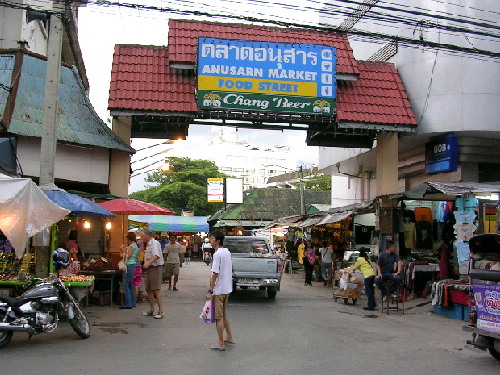
Anusarn Market Entrance to a food-court
Every night while we were in Chiang Mai we went there to taste different types of Chiang Mai food. I found that some of it are not to my liking. Whenever we were there, the place was always crowded and had an atmosphere of festivities.
Day 4: Friday 7 July 2006 Warorot Market
On the last day of our Chiang Mai stay, we decided to go to the largest market in Chiang Mai where local people buy their daily needs in the morning. It is called Warorot Market by the Ping River.
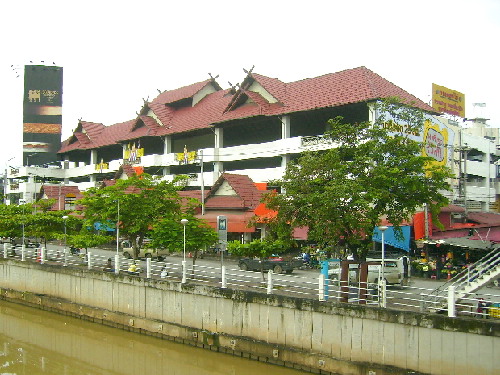
Warorot Market by the Ping River, Chiang Mai
When we arrived at the market, we saw lots of roadside stalls selling things ranging from fresh vegetables and fruits to breakfast food and fresh flowers. Customers who were mostly ladies went there by their own cars, motor-cycles, minibuses, tuk-tuks and trishaws and were busy buying daily needs from the roadside stalls and stalls inside the market.
There are many shops near the market selling goods ranging from handicrafts to shoes and clothes. We went to a few apparel shops to check the prices of some clothes and found that they were cheaper than those we had bought at the Night Bazaar along Chan Klan Road.
The National Anthem of Thailand While we were busy buying some
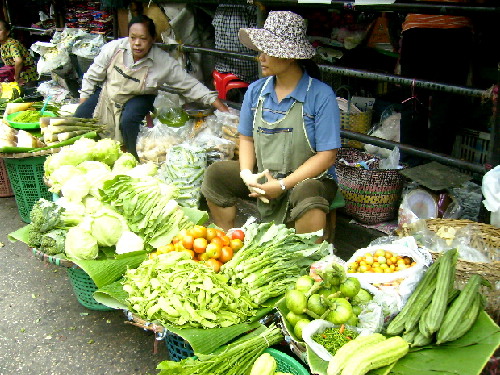
A vegetable seller at Warorot Market, Chiang Mai
snacks from a roadside vendor, we were surprised to see people on the roads and in the shops standing motionless. Then we realized that the national anthem of Thailand was being played loudly from loud-speakers. Quickly, we did the same. When it was over, the people continued doing their own activities. Later, I was told that the Thai national anthem is played twice a day, i.e. 8 a.m. and 6 p.m. and the Thais always respect their national anthem.
After shopping at the market and nearby shops, we went back to our hotel to pack our luggage. We had to catch a flight back to Malaysia at 11.05 a.m.
Departure to Malaysia
Old Chiang Mai City As we had about an hour to wait for a minibus that would bring us to the airport, I alone
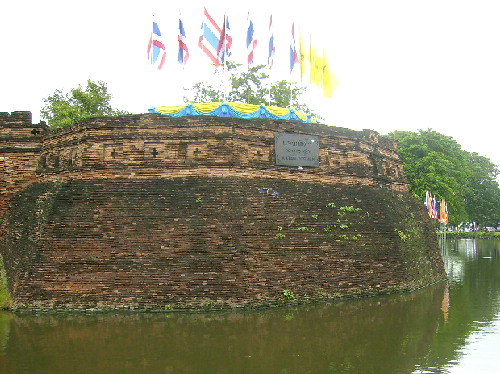
One of the corners of the old city fort knwn as Katam Centre
decided to see the old Chiang Mai City which is just opposite the Lai-Thai Guest House where we had stayed for the last three nights.
The old city was established by King Mengrai and is now 700 years old. To protect the place, the king built a rectangular brick-fortress (1.8 km x 2 km) round it and a moat surrounding the fortress for more protection. Most of the fortress is now gone except the corner walls and the gates. The moat has several fountains which look beautiful at night when coloured lights are switched on.
Wat Chay Mol Muang After walking for a few minutes in the old city, I
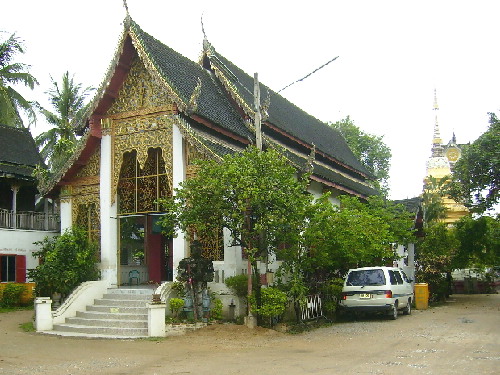
Wat Chay Mol Muang (Phrasing Muang) in the old city of Chiang Mai
came across a small Siamese temple which is known as Wat Chay Mol Muang (Phrasing Muang). It is like any other Siamese temple: a hall that houses a large statue of Buddha, a stupa or chedi at the back, a general purpose hall and living quarters for an abbot and monks.
At 10 a.m. we left the Chiang Mai City for the airport. Then at 11.20 a.m. we flew back to Kuala Lumpur, Malaysia, by Air Asia again.
Why is Chiang Mai a tourists’ favourite destination?
Undoubtedly, Chiang Mai is one of the tourists’ favourite destinations. Its peoples’ friendliness, politeness and hospitality make the tourists feel welcome and happy. Besides, a tourist has no worry of terrorism there as its
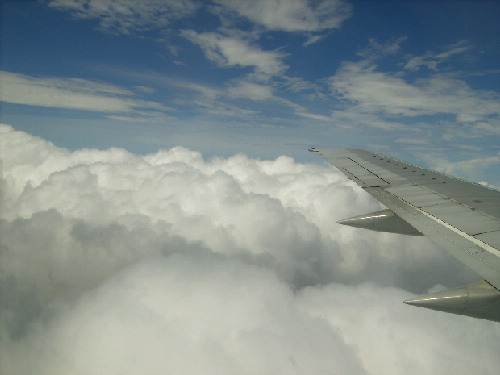
Writer and his tour members flying back to Malaysia from Chiang Mai
people of different ethnic groups and cultures have been living in peaceful coexistence for a long time.
Chiang Mai offers a variety of activities for tourists such as watching animal shows, visiting hill-tribes, rafting, jungle-trekking, shopping at the Night Bazaar, tasting local foods, experiencing the peace and quiet at its beautiful temples and many more. It is not surprising to hear some tourists saying that they have gone to Chiang Mai a few times.
Thank you for reading this travelogue and hope you will make a trip there.
Written by: Choo Chaw, Kluang, Johor, Malaysia
Comments
Tell me what you're thinking...
and oh, if you want a pic to show with your comment, go get a gravatar!
